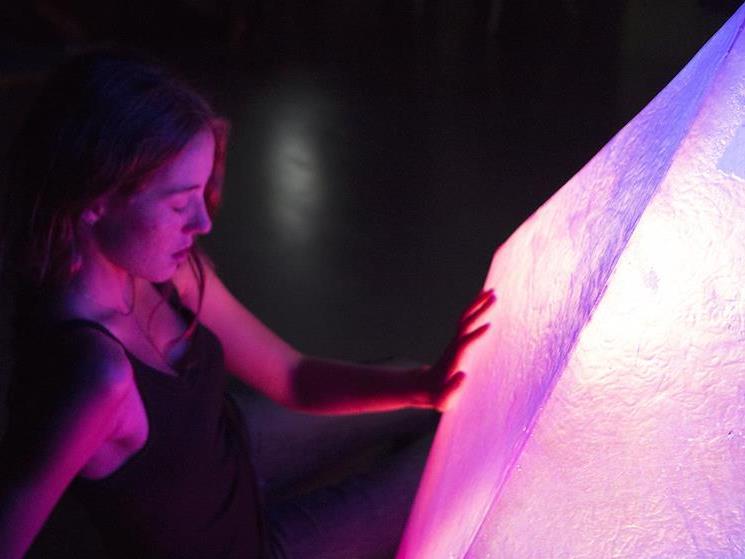Snoösphere by Lull Studios. Image supplied.
Finding ways to improve mental health in Australia is becoming increasingly important. According to the NSW Mental Health Commission, suicide is the leading cause of death for young Australians aged between 15 and 44, and 65% of Australians with a mental health problem don’t seek help — which is why starting a conversation on the subject is a crucial first step.
The Big Anxiety Festival creates a space to start this conversation and also explore the role the arts play in improving mental health. Leading artists, scientists, technology experts and thinkers have been assembled to help change the way people think about and deal with mental health, with festival events staged across Greater Sydney from 20 September to 11 November.
‘We want to change things. We do feel that people can use the arts to improve their mental health and find out more about mental health, to understand it and manage it better. Some of the works that we present do it in big ways and some do it in very small ways and trigger a new way of thinking that is perhaps quite modest. But the idea that we can open up conversations and set something in motion, I think that is really exciting,’ said Professor Jill Bennett, Australian Research Council Laureate Fellow and Director of The Big Anxiety Festival.
‘It is a community festival, but it is also a festival that brings together world leading experimental artists. We have a lot of experimental practice — immersive environments and high-tech interactive projects.’

Can we design a pod to support good mental health, and calm, focused attention, for use in public schools? This was the challenge laid down in The Big Anxiety’s mental health design competition. Image of Mental Health Pods developed by two teams of spatial design students.
As the broader public comes to understand mental health through new research and ongoing education, we have also learned that the arts can contribute significantly to the mental health space. A study conducted at the University of Otago recently found that engaging in the arts improves a person’s mood not only in the short term, but actually over a longer period of time than previously thought.
‘There is all sorts of evidence like that which really suggests that we could use the arts more in the mental health area, at the same time as some people would say we have a mental health crisis and that we don’t have enough resources to deal with that,’ said Bennett.
‘We’ve done a lot of work in this area, but also globally there is an increasing amount of evidence that suggests participating in art, either by doing it or being a spectator, is really good for a person’s mental health.’
About the program
The festival includes 60 events structured around five themes: Awkward Conversations; Lived Experiences; NeurodiverseCity; Power, Politics and Institutions; and Mood Experiments.
The Awkward Conversations are one-on-one conversations that individuals can book throughout the festival period. ‘Instead of hearing someone give a lecture, these conversations address different aspects of anxiety in a very relaxed format with artists and people with lived experience,’ explained Bennett.
‘We wanted to do things on a different scale. It is a genuinely inclusive and participatory festival.’
The festival program also includes state-of-the-art immersive environments, international art exhibitions, and performances. Importantly, one of the main considerations is how the festival can build capacity in different ways. For example, Mood Experiments explores the different ways our environment influences the way we experience the world.
One of the experiments in the program is the multi-sensory environment Snoösphere, inspired by stimulation and relaxation environments used in care and rehabilitation contexts in the Netherlands. Snoösphere was designed by Lull Studios in collaboration with autistic artists. The result is a carefully calibrated space that promotes relaxation and explores the role of design in developing new strategies to make spaces accessible for neurodiverse people.
‘Anxiety is a concern for many autistic and neurodivergent people. They were coming to us and saying “Cities make us anxious and being in crowded places make us anxious.” The world is not actually designed to support people who are neurodivergent and cities tend to provoke anxiety so we started thinking about how to design spaces that don’t provoke anxiety but are more relaxing,’ said Bennett.
Other highlights include Dis/ordered by Clive Parkinson, the Director of Arts for Health at Manchester Metropolitan University — an empowering presentation that incorporates innovative video and performance to investigate the experience of anxiety — and the immersive experience Parragirls Past, Present.
Parragirls rewrites the public history of the former child welfare institution Parramatta Girls Home. This work includes a self-guided audio walk at Parramatta Girls Home and a VR project at the Parramatta Riverside Hub.
‘We have this really rich resource in the arts that can really make a difference. That’s something we want to explore and we are really interested in how to achieve and also measure that impact. That can be in terms of making people feel better and engaging in activities to help them improve their mood, or also, in the bigger picture, promoting reflection and insight into mental health and promoting empathy and understanding,’ said Bennett.
To find out more about the festival, visit https://www.thebiganxiety.org





